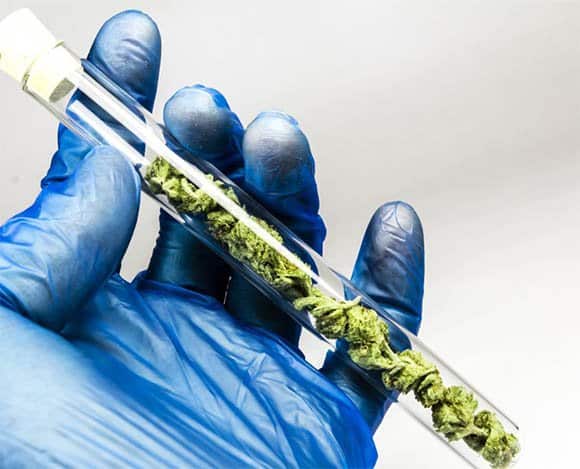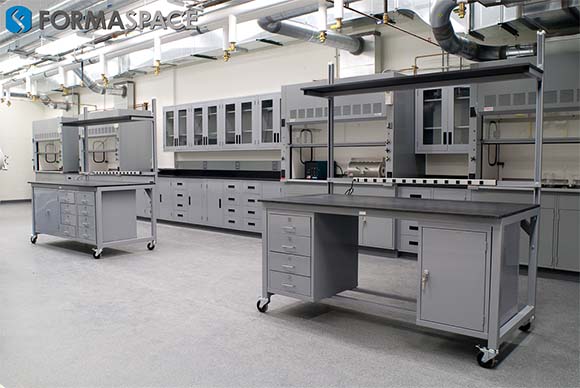
We recently caught up with Satto Rugg who, with business partner Nicole Delmage, launched MerJ Architecture last year. His firm is a cannabis-specific architecture firm specializing in the design of testing labs, retail dispensaries, plus facilities for the growing, cultivating and processing of cannabis. Satto is an established architect with 20 years’ managing a general practice architecture firm that provides services for commercial, residential and other more traditional projects.
Satto recognized the potential of providing services for the rapidly growing cannabis industry in his home state of Colorado after it became the first state in the U.S. to legalize the sale of marijuana for non-medical use in December 2012.
Currently, according to the National Conference of State Legislatures, cannabis is legal for medical use (with a doctor’s recommendation) in 29 states. Another 17 states have laws allowing for the medical use of a THC-limited version which is non-psychoactive. Another 13 states plus the U.S. Virgin Islands have decriminalized it for recreational use.

 State Cannabis Programs, Effective July 1, 2018 – Data obtained from National Conference of State Legislatures – Vector map from Blank US Map.svg by Theshibboleth
State Cannabis Programs, Effective July 1, 2018 – Data obtained from National Conference of State Legislatures – Vector map from Blank US Map.svg by TheshibbolethDescribed as the “fastest-growing industry in the U.S.” by the Huffington Post, the cannabis business is expected to continuing its impressive compound annual growth rate (CAGR) of 26% thru 2021, according to Arcview Market Research/BDS Analytics. Or, in dollars terms, the industry that reached $6.73 billion in sales in North America in 2015 is projected to reach $21.6 billion by 2021.
Beyond sales, growth in the industry has translated to jobs as well. The job website ZipRecruiter notes that jobs posting for cannabis industry positions increased 445% in 2017, significantly more than the 18% growth rate reported for 2016. In the U.S., the cannabis industry now employs from 165,000-230,000 full- and part-time workers.
Satto has already established credentials in this expanding industry. MerJ Architects has existing or pending projects in several states — including Colorado, Iowa, Washington, Oregon and California.
He notes: “Cannabis facilities is where our expertise lies – the industry presents an array of highly technical challenges that present a steep learning curve for architects. Regulations from local and State jurisdictions are often very confusing to clients. We’ve been through it before, and we know how to design within the parameters and get you up and running as quickly as possible.”
We dug a bit deeper into the potential business opportunities in the economic juggernaut we call California. The state legalized the recreational use of marijuana on January 1st of this year and the California State Finance Department is projecting recreational use retail sales of $3.4 billion in the first year a 22% annual growth rate. However, industry experts suggest this figure might be an underestimate. Recreational use of marijuana in the first year grew by 40% in Colorado and by 50% in Washington, as reported by The Hill.
“While we are receiving inquiries from California, there is a lot of uncertainty as kinks in the new regulatory process are worked out, and that is making it difficult for new businesses to get started,” Satto noted, adding that he believes cannabis industry expansion opportunities are not limited to just that state. “Over the next five years or so, a lot of states will be coming online.”
His prediction will likely match reality. In 2018, seven more states will see legislation on legalizing cannabis for recreational use, and five others for approving it for medical use, reports the Medical Marijuana, Inc. News.
And MerJ Architects is poised to be at the forefront of this facet of the growth related to the cannabis industry.
Cannabis Testing Laboratories Revenues Projected to Explode
Cannabis testing laboratory revenues in the U.S. alone are expected to reach $850 million by 2020, according to independent investment research and advisory firm GreenWave Advisors that focuses on the industry. Worldwide, that figure rises to an estimated $1.4 billion per year by 2021 at a projected year-over-year growth rate of 10%, according to the global research firm Markets and Markets.
In the U.S., the importance of cannabis testing laboratories will likely expand exponentially as more states pass laws legalizing the medical or recreational use of marijuana, and product lines expand into more edible, ingestible oil, topical as well as vaporized product offerings. The need for cannabis testing laboratories will also increase with mandated testing and when testing practices and methodologies are standardized. State and local legislators, health officials, cultivators and others will refine their needs for product testing and quality assurance. (You can learn more about this topic from the Formaspace blog “Will Laboratories Embrace Medical Cannabis as Marijuana Legislation Takes Hold?”).
Just as oversight by local jurisdictions can present complications for those entering any segment of the cannabis industry, laboratory testing is a vital component to ensure health and safety of the public through quality products
Knowledge of Cannabis Industry Plus Facility and Operating Regulations is Key to Success for Cannabis Testing Labs
Since states have different requirements and there is no one established standard at present, we wondered if that presented a problem for the MerJ Architects team.
“There are regulations that the state and local jurisdictions pile on. That’s where we help our clients. Laboratories have specific issues – they have highly technical electrical, ventilation, air filtration and cleanliness requirements. That’s what we do – we set up laboratories and that is a part of our work in the cannabis field,” Satto said, adding “The great thing is that once you have experience in the field, even if a new state comes online, they tend to have similar regulations and codes. We can be quite helpful in the process of helping a company get the licensing and the permits.”
Knowledge about current regulations and what Satto terms the infrastructure of the cannabis testing lab is key. (You can learn more about the certification regulations in your state from the Formaspace blog “How to Start a Cannabis Testing Lab” and in resources available on the Leafly website).
“It is very important because of the complexity of the infrastructure for the lab itself in terms of water, gases, ventilation and air cleanliness. The HVAC system and the plumbing and other supply systems are critical, as well as lighting and cleanable surfaces. This knowledge is just a lot for an inexperienced architect to pick up,” Satto said.
Are Existing Testing Labs or Current Cannabis Operations More Likely to Expand into Cannabis Testing Services?
Our curious minds led us to ask who is entering the field of cannabis testing laboratories? We wondered if it is existing testing laboratories that are expanding into cannabis testing, or if cannabis companies already involved in some other aspect, say, cultivation is seeking to add testing to their operations?
“Both, actually, and pretty evenly in our experience so far. Some companies come from the cannabis growing side and they start getting into extraction, processing, and testing. Other companies come already from the product testing side and they may not have experience in cannabis, but they have a strong laboratory background and they enter the cannabis field,” Satto explained.
Does MerJ Architects find either of these operational pedigrees more challenging to work with when designing cannabis testing laboratories?
“If I am designing a laboratory for an organization with existing laboratory experience, that is easier because they know what machines and equipment they require. But if that company doesn’t already have lab testing experience, even if they are already in the cannabis business, we have to help them with programming – figuring out equipment and process flow,” Satto observed. “In this case, we would also bring in a consultant to dial in their equipment needs. This is nothing you want to guess at – there’s too much money involved, and the science of cannabis testing is constantly evolving.”
We decided to put ourselves in the shoes of a MerJ Architecture client. The first question that popped into our minds involved the financial investment.
“‘How much will it cost?’ is a big question that we can’t answer directly here, but we have some experience with that. What our clients often want to know is if they will be able to build in a certain building. Say, they’re moving into an existing building. They want to know if it will support a laboratory, and what they need in terms of electrical, power, HVAC, security and the tangible items like lab benches and lab furniture. That is a big part of it,” Satto explained.
Since building a cannabis testing laboratory involves a large capital investment, we asked how MerJ Architecture helps its clients invest wisely in a facility. We know that specialized testing equipment requires precision installation and must be maintained in a clean environment. How can a testing laboratory provide for long life and durability of specialized and expensive equipment?
Satto noted: “Often the lab technicians or the manager of the lab has very specific ideas about what machines goes where, and what cabinets go where. So, the easy configuration ability of a component from a custom lab furniture manufacturer makes it much easier to deliver to the client exactly what they want. Some of the equipment is very heavy, over 500 pounds sometimes, and the machinery is very vibration sensitive. Formaspace has created solutions for all these issues. Their lab tables are very strong and able to support pretty much whatever you want.”
He added: “Testing in a lab involves all kinds of chemicals that can be corrosive and damaging to furnishings. Our clients want to know that when these chemicals are being used, their equipment surfaces will be resistant. They also want to know that all the surfaces are designed to be thoroughly cleanable.”
What Knowledge and ‘Must-Have’ Design Elements Do Successful Cannabis Testing Lab Embrace?
That information from Satto lead us to ask what are the “must-have” design elements for a successful cannabis testing laboratory.
“Ventilation and exhaust systems are very important. The electrical power supply that is specific to all the scientific machinery is too. The cleanliness factor in terms of air cleanliness, filtering, and water treatment for lab processes and washing the lab equipment is vital.” Satto added: “Safety is another big area. You may need flammable gas alarm systems, eye wash stations, and emergency showers. Plus, security is a big issue with all cannabis work. A high level of security is required by most jurisdictions.”
Satto said key to the success of a cannabis testing laboratory is being thoroughly familiar with the infrastructure of the facility in order to develop a design that accommodates specialized and large equipment, working areas, storage and safety areas, plus ensuring security while meeting operational and administrative needs.
Satto sums up his best advice for those interesting in starting a cannabis testing laboratory: “It’s very important to assemble a team of experts to help design the facility and navigate the maze of regulations. As architects, we head a team of mechanical and electrical engineers, custom lab furniture manufacturers such as Formaspace, and others who are familiar with the rigorous standards of cannabis testing labs. We can do it much faster than most others or someone starting from scratch. I think that is the most important thing, to have the right team on the design end – it’s starting off on the right foot.”
To learn more, contact us today by filling out the quick form below. Our Formaspace Design Consultants are ready to help you today.














